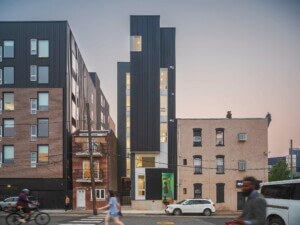As architects descend for the 2016 AIA National Convention, the City of Brotherly Love will be in the spotlight. Philadelphia was just named a World Heritage City, the first in the United States. Denise Scott Brown (see our interview with her here) and Robert Venturi will be awarded the AIA Gold Medal during the convention and a new mayor is fighting to preserve the city’s landmarks, which include the Liberty Bell, Independence Hall, Philadelphia City Hall, and a host of modern and postmodern relics—not to mention the urban fabric that composes the neighborhoods. In light of all that is happening, AN dove head first into Philadelphian architecture, both past and present. (Also, our “reader” of past articles can help you get up to speed on Philly, the AIA, and this year’s speakers.)
This year Philadelphia—home of the Liberty Bell, Independence Hall, and Rittenhouse Square—can boast of another historic attribute: It is the first and only city in the United States to be named a World Heritage City, one of 266 around the globe.
Civic leaders, who received word of the recognition last fall, note with pride that it gives Philadelphia a distinction that big-city rivals such as New York and Boston can’t claim. They hope it will make residents more aware of the city’s historic assets and help draw more tourists .
However, a letdown is that the World Heritage City designation doesn’t offer Philadelphia any money to protect or promote historic buildings. It comes from a Canadian group, the Organization of World Heritage Cities (OWHC), not the United Nations Educational, Scientific and Cultural Organization (UNESCO), and it provides no funds for preservation.
Some fear the designation could lull people into a false sense of security about local preservation activity. “There’s been a tremendous amount of confusion,” said architect Kathy Dowdell, principal of Farragut Street Architects. “It’s essentially a marketing campaign. It doesn’t actually protect anything. But if it gets people to think about the need to protect [historic buildings], I don’t care if it is a marketing campaign.”
Despite its recent designation as a World Heritage City, Philadelphia has had a decidedly uneven record and reputation for historic preservation. Architects who come to the AIA convention will find Center City relatively intact. But other areas of the city are losing historically and architecturally significant buildings at a steady rate, largely due to development pressures and lack of landmark protection.
This spring, many residents are smarting from the recent loss of the main auditorium of the Boyd Theater, the city’s last movie palace, and the former Union Baptist Church, where Marian Anderson learned to sing. Compared to its peers, local preservationists say, Philadelphia is doing a poor job of safeguarding its historic assets. More than a few describe the preservation scene as being in a state of crisis.
“There is a real culture of despair, or resignation, when it comes to preservation in this town,” said Aaron Wunsch, assistant professor in the University of Pennsylvania’s graduate program of historic preservation, in an interview with PlanPhilly, a website that monitors preservation activity in Philadelphia. “It’s not that people don’t care; it’s either that they assume that the system is working, or have given up on it ever doing so.”
Lack of imagination is one of the city’s problems, Wunsch said.
“Philadelphia has become a real can’t-do kind of place, unwilling or unable to think creatively about preservation and adaptive reuse. We have the architectural resources of a Colonial Williamsburg for the 18th century, and far better than Manhattan for the 19th. But we continue to think like Detroit, treating every development proposal, no matter how shoddy, as our city’s last hope.”
“My feeling is that there are two different stories here,” said Nathaniel Popkin, writer, critic, and editorial director for Hidden City Philadelphia, another organization that pays close attention to preservation in Philadelphia.
“Some people will tell you that there is a crisis. There is certainly a feeling that the regulatory process is not working…On the other hand, there is an enormous amount of preservation work happening —high quality preservation work and high quality adaptive reuse work—and there is opportunity for much more.“
Philadelphia seems to regard preservation differently than other cities do, observes Inga Saffron, The Philadelphia Inquirer’s Pulitzer Prize-winning architecture critic.
“In most cities, historic designation means a building is protected—forever,” she wrote after the city’s historic commission approved a proposal to tear down the Boyd auditorium. “In Philadelphia, designation is increasingly seen as a temporary state, good until a developer offers a compelling alternative.”
Despite the recent losses and threats to the city’s historic fabric, no one has given up hope. New Mayor James Kenney took office in January, and preservationists are optimistic that he and his administration will put preservation on a better course. They note that Kenney once worked for a local architectural firm that specializes in preservation, Vitetta, and that as a city council member he introduced legislation that would have added landmarks to the Philadelphia register and doubled funding for the historic commission. The legislation never passed, in part because Kenney left the council before it could advance. But it underscored his passion for preservation.
As the new mayor settles in, Philadelphia’s preservation scene is a study in contrasts. On the plus side, Philadelphia has one of the richest collections of historic buildings in the country and a sophisticated citizenry that understands the importance of preservation. The Philadelphia Historical Commission was formed in 1955, making it one of the country’s preservation pioneers. Philadelphia has excellent architecture and preservation schools, first-rate architects and builders; strong philanthropic organizations, and a longtime preservation advocacy group, the Preservation Alliance of Greater Philadelphia.
But the city faces an uphill battle in protecting its assets for a variety of reasons. The historic commission has one of the lowest budgets of any big city preservation agency in the country—less than $500,000 a year. With the limited budget, commission staffers devote much of their time to processing building permit applications rather than preparing reports recommending new landmark designations. Only about two percent of the city’s buildings have any sort of local landmark protection.
Designated landmarks aren’t necessarily safe from the wrecking ball either. Over the years, the historic commission has approved a number of requests to demolish buildings after owners argued it would be a financial hardship to maintain them. The city has few tax incentives for preservation.
Much of the problem, said Popkin, can be traced to the city’s loss of manufacturing jobs in recent decades and its subsequent budget woes. In addition, Popkin said, Philadelphia never had the sort of overheated real estate market New York City has. As a result, he said, the historic commission has been perennially understaffed, underfunded, and ill equipped to cope with the sort of development pressures it’s facing now.
In awakening from its real estate doldrums and embracing urban revitalization, the city sometimes acts as if it never learned the lessons of the past 50 years about preservation and urbanism, Wunsch said. “It’s almost as if Jane Jacobs never existed.”
The city’s lead public official in charge of preservation efforts, Historical Commission executive director Jonathan Farnham, offered no comment for this article. In other interviews, Farnham has defended his commission, saying he thinks it does well given its budget and staff size. He disagrees with those who complain that the commission isn’t recommending enough buildings for landmark status. He denies that it sides with developers too frequently.
How can the situation be improved? In an op-ed for the Inquirer, Wunsch and Preservation Alliance executive director Caroline Boyce urged the city to increase funding for the historic commission; undertake a comprehensive survey of Philadelphia’s historic resources, and provide tax incentives for preservation, among other suggestions.
Another key to any turnaround would be for elected officials to demonstrate the political will to make preservation a higher civic priority, and that’s where Mayor Kenney comes in.
Carl Dress, principal of Heritage Design Collaborative of Media and chairman of AIA Philadelphia’s Historical Preservation Committee, said he’s encouraged that Kenney wants to rehab and reopen older libraries and recreation centers. In addition, he said, the city is moving its police headquarters from one older building, the Roundhouse by GBQC, to the former Provident Mutual Life Insurance building in West Philadelphia. It also hired Kieran Timberlake to refurbish the “Saucer” welcome center at LOVE Park.
“There are great hopes that he will help take preservation in the right direction,” Dress said of Kenney. During last year’s campaign for mayor, “Kenney was the first person to talk positively about preservation in as long as anyone can remember,” Popkin said. “He understands it. He gets it…Hopes are very high.”










